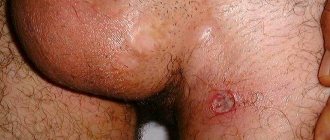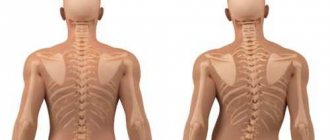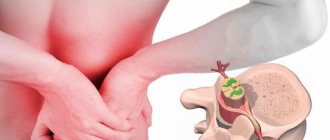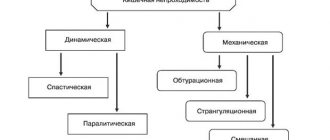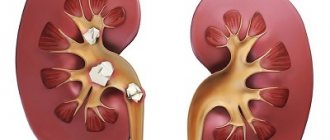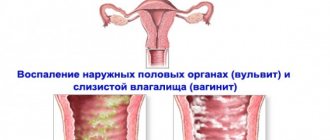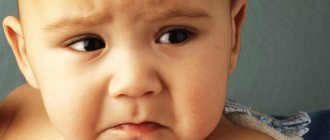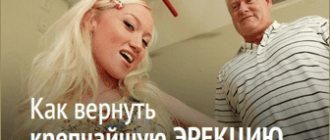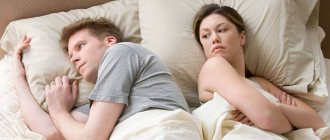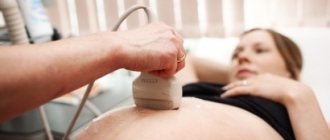Symptoms
The pathology in half of the lesions is asymptomatic. It is not always possible to diagnose a disorder at home without a visual examination by a doctor. The pain appears only after prolonged physical exertion and is localized at the site of the curvature. At the same time, severe fatigue occurs.
To diagnose disorders, the patient needs to stand upright with equal support on both legs and lower his arms down. This pose makes it possible to note violations of the symmetry of the back. Characteristic signs of scoliosis at stage 2 are:
- placement of shoulders at different heights;
- mismatch of lines between the corners of the shoulder blades, one of them will stick out;
- deviation of the spine to the side when bending forward, the scapula rises pathologically;
- pain syndrome;
- when you feel the place of curvature, you feel a dense roll of muscles;
- Asymmetrical folds are visible in the buttock area.
Specific signs of the disease include:
- protrusion of the costal arches and lumbar muscles;
- depression in the thoracic region from the back.
Specific manifestations of the lesion indicate the development of torsion. This is the twisting of the vertebrae around their axis. This condition is very dangerous due to the risk of organ displacement, leading to disability.
Causes of scoliosis in children
- Insufficient development of muscle tissue and ligaments. Scoliosis usually develops in children with rickets.
- Abnormal development of vertebrae and ribs.
- Extensive scars, burns.
- Scoliosis of unknown etiology (idiopathic).
In the early stages, scoliosis in children is almost impossible to detect. It may be noticed by an orthopedic surgeon during regular examinations. Prescribing timely treatment can stop the progression of the disease and prevent it from reaching severe forms.
Possible complications
If treatment measures are not implemented in a timely manner, then the following complications develop:
- pain in the back;
- persistent fatigue;
- labored breathing;
- frequent cough;
- bronchitis;
- curvature of the chest;
- disorders in internal organs - kidney prolapse;
- in case of pregnancy - its severe course and difficult childbirth.
A conscript with 2nd degree of pathology receives category B, that is, he is partially fit for military service.
Types of scoliosis
The main classification of stage 2 curvature in the spine is to divide it into right-sided and left-sided types. Also, according to the shape, the curvature is classified into S-shaped, Z-shaped and C-shaped.
Right-handed
There is pronounced deformation of the spine to the right. In case of development in the cervical spine, the following occurs:
- frequent attacks of headache;
- stiffness when moving;
- pain in the neck;
- numbness of hands;
- pain when moving your head;
- less commonly, deformation of the skull bones.
When the pathology affects the thoracic region, the following appear:
- limitation of motor activity throughout the body;
- muscle spasm;
- pain during movements;
- normal arrangement of organs;
- dysfunction of the heart and blood vessels;
- pronounced asymmetry in the shoulders and shoulder blades.
Curvature to the right in the lower back changes the position of the pelvis and provokes serious problems with internal organs. A person’s gait changes and he gets tired very quickly. Almost always the condition is accompanied by problems in the functioning of the reproductive organs.
Right-sided and left-sided curvature
Left-handed
With this form, the curvature is directed to the left. The symptoms are quite vague at first, but as the disease actively develops, dangerous degenerative changes occur in the spinal column.
Main symptoms of the disease:
- lower back pain;
- osteochondrosis;
- loss of sensation in the limbs.
Severe degrees of left-sided scoliosis are rarely detected, mainly in elderly people. There is a strong asymmetry.
Myths about the consequences of scoliosis
There are a lot of myths about scoliosis on the Internet, sometimes quite absurd. Below are the most popular ones:
Myth No. 1. The main symptom of scoliosis is back pain. This statement is far from reality, because... Curvature itself rarely causes such pain.
Myth No. 2. Scoliosis can cause paralysis. In fact, paralysis with scoliosis is possible only in one case - if the patient with curvature receives a serious spinal injury.
Myth #3: Scoliosis increases the risk of disc herniation. Doctors say that a disc herniation has nothing to do with scoliosis, as it appears as a result of injury, unsuccessful movement, or sudden compression of individual segments of the spine. According to statistics, disc herniation is found in healthy people as often as in patients suffering from scoliosis.
Myth #4: Scoliosis can lead to arthritis. Arthritis refers to inflammation of the joints that occurs when the immune system malfunctions. This failure can be caused by a viral infection, hypothermia, stress, colds and even severe metabolic disorders. It is in no way connected with the curvature of the spine.
Myth No. 5. Curvature can cause the development of arthrosis of the hip and knee joints. In fact, patients with scoliosis are not considered to be at risk for arthrosis. The likelihood of developing arthrosis is much higher in people with congenital abnormalities of joint development (hip or knee dysplasia).
Myth #6: Scoliosis can cause numbness in the lower and upper extremities. Similar judgments can be heard from many patients suffering from scoliosis. However, it is not the curvature that is to blame for numbness in the arms and legs, but neurological disorders or hypermobility syndrome. These same disorders can cause scoliosis. Thus, scoliosis and numbness are consequences of various health problems.
Myth No. 7. Scoliosis always leads to infertility in women and erectile dysfunction in men. This statement is only half true. Scoliosis can indeed change the functioning of the pelvic organs. However, a huge number of patients psychologically suffering from spinal curvature manage to lead an active sex life. There are also a huge number of women who become pregnant and give birth to children despite scoliosis.
Myth No. 8. Against the background of scoliosis, immunity deteriorates, allergic reactions, colds and even cancer develop. The truth is that scoliosis is not related to any of the listed pathologies. Patients with spinal curvature suffer from cancer, allergies and colds, but not more often than people with healthy backs. Allergies, frequent colds - they all appear due to malfunctions of immune cells, chronic stress, poor nutrition, unfavorable environmental conditions, etc. However, scoliosis has nothing to do with it.
Is it possible to cure scoliosis?
The earlier the correct diagnosis is made, the easier it is for the doctor to take effective measures to get rid of the problem. In children and adolescents at stage 2, the disease progresses rapidly as the spine grows simultaneously. The recovery is quite long because the spine loses its flexibility, which normally should only go away by the age of 22.
Due to the curvature, the shape of the chest changes. This problem provokes the formation of a rib hump.
For an adult, grade 2 scoliosis is not such a dangerous condition, since the spinal column has already passed the growth stage, which means the risks of complications are several times lower. But correcting curvature for adult patients takes longer and is more difficult than for adolescents or children.
Nutrition and diet for scoliosis
Scoliosis is a fairly common disease that most often occurs in childhood and is accompanied by unpleasant symptoms. To improve a person’s condition with spinal curvature, it is necessary to strictly follow all medical recommendations. One of the important elements of complex treatment is proper nutrition. With this diagnosis, the diet should be rich in vitamins and microelements.
What substances are needed for scoliosis
To ensure proper functioning of the spine and skeletal system, the human diet must contain useful vitamins and microelements:
- calcium;
- magnesium;
- phosphorus;
- manganese;
- vitamin A;
- vitamin D;
- B vitamins;
- vitamin C.
Useful products for scoliosis
To increase the effectiveness of scoliosis treatment, it is very important to review the patient’s diet. To improve a person’s condition, the following categories of products are prescribed:
- Protein food. This is especially important if scoliosis is diagnosed in a school-age child. It is these products that contribute to the active growth and development of the body, saturating it with vital energy. Valuable sources of protein include rabbit and chicken meat, turkey, cottage cheese, fish, and lean lamb. Vegetable protein foods are also useful - peas, beans, peanuts.
- Fruits and vegetables. These products must be included in the menu of a person with this diagnosis, since they include many vitamins and nutrients.
- Cereals. The diet should include cereals such as rice, oatmeal, and buckwheat. It is no less useful to eat pearl barley, semolina and millet porridge. These foods provide the body with carbohydrates and are a valuable source of energy. In addition, they contain useful substances - iron, magnesium, boron, etc.
- Products containing vitamin E. This substance is an antioxidant and takes part in the formation of bone tissue. It can be obtained from fish, nuts, sorrel, spinach, oatmeal and barley. In addition, vitamin E is found in sea buckthorn and dried fruits - prunes and dried apricots.
- Products with vitamin C. This element is also very important for bone formation. It can be obtained from cabbage, citrus fruits, bell peppers, and black currants. Rose hips, kiwi, and strawberries are rich in them.
- Products with vitamin D. This substance takes part in the regulation of calcium-phosphorus metabolism and has a beneficial effect on the development of bone tissue. This element is present in mackerel, salmon, sour cream, butter and eggs.
- Seafood. They include phosphorus and polyunsaturated acids, which have a positive effect on strengthening the spine and improving the functioning of the intervertebral discs.
- Dairy products. The diet of a person with this diagnosis should contain a sufficient amount of cheese, cottage cheese and other dairy products, since they saturate the body with calcium. Legumes, barley and oatmeal, and nuts are also sources of this element.
- Products with vitamin A. With their help, the absorption of calcium and phosphorus, which are very important for strengthening bone tissue, improves. This substance is found in melon, carrots, pumpkin, eggs, and apricots. It also includes the liver of animals and fish.
- Products with B vitamins. Substances such as B1, B2, B6 and B12 are especially useful. They take an active part in metabolism and help strengthen the collagen framework of bone tissue. Sources of these vitamins are buckwheat porridge, liver, potatoes, beef, spinach, legumes, vegetable oil, walnuts.
What else should you consider when planning your diet?
When choosing a diet for people suffering from scoliosis, the threat of excess weight should be taken into account. Excess kilograms create increased stress on the spine and increase pressure on the vertebrae and intervertebral discs. Excess weight also increases the risk of compression of nerve fibers, provokes wear and tear of cartilage tissue and impaired trophism. In addition, excess body weight leads to a restructuring of biochemical processes in the body and disrupts metabolism. As a result, nutrition and blood supply to the spine deteriorate. Therefore, when creating a menu, you should definitely count calories depending on the patient’s age. In addition, the diet should be based on the principles of proper nutrition.
Harmful foods for scoliosis
It is worth considering that there are certain foods whose consumption is contraindicated. These include the following:
- Fatty dishes, flour products, smoked meats, sweets. These products provoke the appearance of excess weight, which creates additional stress on the spine.
- Large amounts of salt and animal fats. Such components negatively affect the condition of bone tissue and joints.
- Plenty of strong tea and coffee. Consuming too much caffeine causes calcium to be removed from the bones.
- Alcoholic drinks. Alcohol leads to poisoning of the body with toxic substances.
Proper nutrition during the development of scoliosis plays a huge role in the treatment of this disease. To improve your health, it is very important to consume enough vitamins and minerals. That’s why it’s so important to take into account all medical recommendations and be careful about following your diet.
Sources used: lechuspinu.ru
Treatment of scoliosis 2 degrees
For grade 2 scoliosis, treatment is often conservative. Timely organization helps not only to slow down too rapid progression, but also to return to full health. A set of methods, in addition to the use of medications, involves organizing exercise therapy and wearing a medical corset. If development still occurs to the next level of severity, surgery is required.
Self-treatment is prohibited. The doctor organizes diagnostics using radiography, MRI and computed tomography. The earlier therapy begins, the better and faster the results will be. For 2nd degree deformity, treatment involves:
- massage;
- taking analgesics and anti-inflammatory drugs as symptomatic therapy;
- putting on an orthopedic corset or bandage;
- manual therapy;
- physiotherapeutic procedures;
- acupuncture;
- exercise therapy;
- yoga.
Following the rules on how to cure curvature at home leads to a faster recovery.
Physiotherapy
In case of spinal curvature, the main way to correct the disorder is exercise. Gymnastics at stage 2 of the lesion helps to achieve the following results:
- correct your posture, make it more correct, even and, most importantly, symmetrical;
- relieve the spine from heavy loads, relax the muscle corset;
- eliminate imbalance of muscle fibers and ligaments, strengthen them;
- normalize blood pressure, blood flow and relieve headaches through exercises using breathing techniques
Massage
Therapeutic massage makes it possible to remove the curvature even faster. To implement the massage, a technique is used aimed at relaxing muscles that are in a state of spasm, as well as toning those that are stretched too much. Manipulations should only be carried out by a professional.
Massage for scoliosis
Therapeutic massage improves blood circulation in the back muscles, strengthening their frame. The general course of treatment should consist of approximately 15 sessions, and in order to cure the second stage of curvature, it is recommended to repeat it once every six months.
Corset and inclined beds
Using a corset can reduce the load on a curved spine. This fixation does not interfere with freedom of movement, but helps to make corrections. When a child under 15 years of age wears a corset, the chances of recovery increase several times. The device acts on the spine in the lateral direction and also maintains its correct position in front and behind. It must be worn every day until the skeleton finishes forming. At the same time, the doctor monitors the condition of the spine.
Patients are often prescribed to sleep on special inclined beds with hard mattresses. But they will not correct the curvature, they will only stop the progression of scoliosis.
Physiotherapy
Thanks to magnetic and laser therapy, UHF, electrophoresis and other similar methods, the first stages of scoliosis can be quickly and successfully corrected. But when grade 2 develops, such treatment is practically ineffective, and therefore is not included in the correction methods.
Swimming
Therapeutic swimming is noticeably different from amateur and even sports swimming. This is a special set of exercises in water that helps cure scoliosis. It strengthens the muscles of the back and at the same time normalizes curvature.
Classes are selected by the doctor individually, taking into account the side of scoliosis, the patient’s age group and his physical fitness. A contraindication to this treatment is spinal instability.
Hippotherapy
Hippotherapy is the treatment of the spine using horseback riding. But not every patient has the opportunity to implement it. Horseback riding is a very effective addition to conservative therapy for second-degree scoliosis.
Left- and right-sided curvatures are easier to correct. During training at the level of reflexes, all muscle groups are included in the work, so the functioning of the musculoskeletal system is restored. At the same time, a reliable corset of muscles is formed around the spine, and the habit of correct posture is developed.
Manual therapy
Manual therapy is treatment with the hands. The effect can only be obtained by contacting a truly qualified professional. The method is used to correct posture in adolescence, in children under 9 years of age. Metabolic problems, tuberculosis of the spine, and autoimmune pathologies are considered contraindications to exposure.
Surgical intervention
Indications for surgery are complications or advanced stages of the process. In case of second-degree curvature, you can still manage only with conservative methods. But in case of rapid progression, the problem only needs to be eliminated promptly.
For final recovery, it is necessary to carry out comprehensive rehabilitation, organize therapeutic exercises and drug therapy.
Examination and choice of treatment methods
Useful vitamins and microelements for scoliosis
The diet will help improve the condition of scoliosis by providing the body with the necessary vitamins and microelements (especially vitamins B1, B2, C, P, PP). Foods rich in magnesium and potassium salts also have a beneficial effect.
The diet for scoliosis suggests excluding from the diet:
- any drinks with a rich taste; - dishes containing extractive substances.
The menu is based on:
- dishes from lean meats, poultry and fish;
-cereals and pasta;
-vegetable and animal fats;
-tea and coffee (weakly brewed);
-berry and fruit sauces.
Nutrition for scoliosis requires careful analysis, because not only a lack of calcium in the vertebrae leads to their deformation. Against the background of pathology, metabolism is disrupted, so many substances are not absorbed.
If you analyze the advice of nutritionists regarding the quality of food for spinal column deformities, you will notice that many professional diets contain recommendations for the use of pork cartilage in the form of jellied meats, grouts, and so on.
Such advice has a right to exist, since pathological curvatures of the spine are often based on changes in the intervertebral discs, which have a cartilaginous structure. With a lack of nutrients, the discs crack and the spinal column becomes deformed. Eating pork cartilage can theoretically lead to the restoration of cartilage tissue, but it is necessary to constantly monitor cholesterol levels, since these products are saturated with fatty acids.
The second most important microelements in the diet are calcium, phosphorus, manganese and potassium, which are necessary for the normal formation of bone and muscle systems. They help prevent bone loss (osteoporosis). The maximum amount of calcium is found in kidneys, fresh eggs, heart, cheese and liver.
Phosphorus is found in beets, nuts, cabbage, cornmeal and fish. To cover magnesium deficiency in the daily diet, we recommend eating more spinach, legumes, and cucumbers. Manganese – cheese, kidneys, vegetables, melon, artichoke, liver, carrots, pumpkin.
To maintain normal bone structure, it is necessary that the diet contains not only calcium, but also vitamin D3. Without it, calcium will not be absorbed by bone tissue. To enhance the effect of vitamin D formation, we recommend frequent exposure to the sun. When exposed to ultraviolet radiation, this compound is formed in the skin.
Sources used: healthinfo.ua
Prevention
To prevent curvature of the spinal column you need to follow simple rules:
- correctly distribute the work and rest schedule;
- take breaks when doing long periods of sedentary work;
- avoid asymmetrical postures during physical activity;
- monitor your diet, drink vitamin and mineral complexes;
- take walks every day;
- engage in healthy sports;
- try to always maintain your posture and work on a beautiful gait.
If deformities in the spine are detected, preventive examinations by a doctor are required at least 2 times a year to prevent progression of the disease. The patient can stop the progression of the disease and completely restore the spine without surgery and negative consequences only if he constantly works on himself and follows all the doctor’s prescriptions.
Similar:
- What treatment methods for scoliosis in adolescents are most effective at different stages?
- Causes of symptoms and treatment of dysplastic scoliosis
- Causes, clinical picture, diagnosis and treatment of congenital scoliosis, classification of the disease
- Reasons for the development of epiphysiolysis of the lateral malleolus, what forms there are, tactics for correcting the condition
- Treatment tactics for lumbago with sciatica in the acute period, signs of exacerbation
- Causes of development of s-shaped scoliosis of the 2nd degree, symptoms of deformation and its treatment
- Causes of scoliosis in the chest area, symptoms, diagnosis, signs, methods of treatment, prevention and prognosis of the disorder
Degrees of curvature
The risk of scoliosis in each specific case depends on the severity of the pathology. There are four degrees of development of the disease:
- The first degree is the lightest, the curvature is only 10 degrees. The pathology is invisible to the eye and can only be seen on an x-ray. If the problem does not progress, it is considered normal. It is not capable of causing any complications and does not prevent a person from living a normal life.
- Second degree - the angle of curvature is 11-25 degrees. The pathology is noticeable to the eye: in a person, one shoulder girdle becomes higher than the other. In this case, the patient requires therapy, as scoliosis progresses rapidly.
- Third degree - curvature ranges from 26 to 50 degrees. The problem is clearly reflected in the patient’s appearance: he has different heights of his shoulder girdles, shoulder blades and ribs, and his waistline shifts to one side. The patient is prescribed to wear a corset or undergo surgery to fix the vertebrae in the correct position.
- The fourth degree is the most severe, in which the curvature reaches 50 degrees. This defect is immediately noticeable in the patient’s appearance; all organs and systems are affected. Treatment is possible only surgically; conservative therapy is no longer able to produce results.
The consequences of scoliosis can be the most severe, so patients even with the first degree of the disease need to carefully monitor their health. If they notice that the pathology is progressing, they should immediately consult a doctor. In particularly severe cases, curvature of the spine can cause complete disability.
